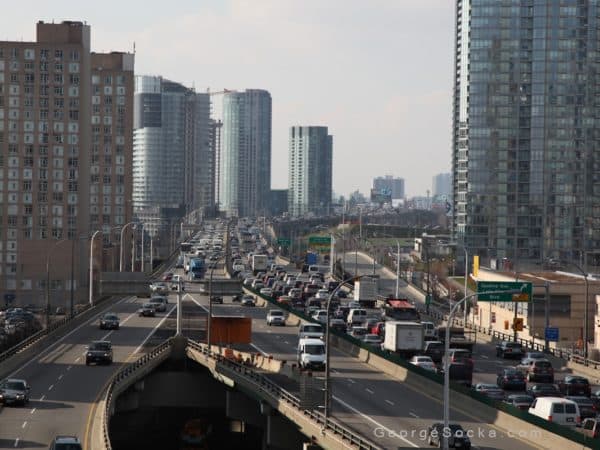Toronto traffic woes: can big data help?


On Monday, Toronto mayor John Tory announced that the city would begin looking at big data solutions to try and cure its famous traffic woes.
“We’re going to get us out of the clicker and clipboard business and into the 21st century,” he said.
The mayor said the city will hire a big data team leader to investigate ways it can ease the gridlock that results from people coming and going to and from places like Markham and Vaughan and Oakville.
Last June, navigation company TomTom issued its fourth annual traffic congestion index, ranking Toronto second worst in the country, behind Vancouver, for congestion. Internationally, Toronto was ranked ninth.
Toronto’s already tough commute has been made worse by ongoing work on the rickety Gardiner Expressway, a major artery in and out of the city that will reopen temporarily from July 10-26 for the Pan Am Games before shutting down once again. Tory estimates that lane closures and travel time delays impacts the city to the tune of a million dollars a day.
So what changes might Torontonians expect from the city’s forthcoming traffic audit?
Los Angeles has been experimenting with forms of technology solutions for decades. That city has employed some solutions that have been years in the making and may be made obsolete by newer technologies. L.A.’s Automated Traffic Surveillance and Control System, which synchronizes traffic lights, was decades in the making and racked up a reported bill of nearly half a billion dollars. The system uses magnetic sensors embedded in the road to monitor traffic through fibre-optic cables.
IBM says its digital traffic-management system, implemented in Stockholm, has cut the average commute time in half.
But in 2015 it seems wasteful to place expensive sensors in the road when most every person and vehicle now moves with them.
A whitepaper from Samsung says the ubiquity of smartphones may revolutionize traffic.
“Smartphones, for example, not only create the opportunity to provide services to users, but they are also sensors in their own right and hence rich sources of data,” says the report. “New devices throw off reams of data that can significantly aid the provision of real time transport services.”
The study, called “Is big data about to transform your commute?” says Wi-Fi and Bluetooth location data could provide advanced analytics that could be used to improve passenger flow. It says technologies such as Near Field Communication and bar codes could speed up ticketing. Samsung also points to sentiment monitoring on social media and even biometric wrist-bands that could be used to measure the physiological response of travelers.
IBM says its digital traffic-management system, implemented in Stockholm, has cut the average commute time in half.
The system employs GPS devices in more than 1500 cabs providing data that is then processed through IBM’s streaming analytics software, InfoSphere Streams, to give the city and residents real-time information on traffic flow, travel times and commuting options. The city also uses lower-tech solutions such as better signage and more road assistance vehicles.
IBM’s solution has also been used by cities such as Dublin, which says it has seen an improvement in the movement of its more than 1000 buses.
Below: John Tory visits Ryerson’s Digital Media Zone…
Nick Waddell
Founder of Cantech Letter
Cantech Letter founder and editor Nick Waddell has lived in five Canadian provinces and is proud of his country's often overlooked contributions to the world of science and technology. Waddell takes a regular shift on the Canadian media circuit, making appearances on CTV, CBC and BNN, and contributing to publications such as Canadian Business and Business Insider.
